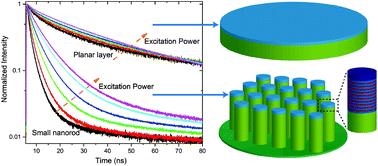Our official English website, www.x-mol.net, welcomes your
feedback! (Note: you will need to create a separate account there.)
Free charges versus excitons: photoluminescence investigation of InGaN/GaN multiple quantum well nanorods and their planar counterparts†
Nanoscale ( IF 5.8 ) Pub Date : 2018-02-12 00:00:00 , DOI: 10.1039/c7nr07567g Weijian Chen 1, 2, 3, 4, 5 , Xiaoming Wen 5, 6, 7, 8 , Jianfeng Yang 1, 2, 3, 4, 5 , Michael Latzel 9, 10, 11, 12, 13 , Robert Patterson 1, 2, 3, 4, 5 , Shujuan Huang 1, 2, 3, 4, 5 , Santosh Shrestha 1, 2, 3, 4, 5 , Baohua Jia 5, 6, 7, 8 , David J. Moss 5, 6, 7, 8 , Silke Christiansen 9, 10, 11, 14, 15 , Gavin Conibeer 1, 2, 3, 4, 5
Nanoscale ( IF 5.8 ) Pub Date : 2018-02-12 00:00:00 , DOI: 10.1039/c7nr07567g Weijian Chen 1, 2, 3, 4, 5 , Xiaoming Wen 5, 6, 7, 8 , Jianfeng Yang 1, 2, 3, 4, 5 , Michael Latzel 9, 10, 11, 12, 13 , Robert Patterson 1, 2, 3, 4, 5 , Shujuan Huang 1, 2, 3, 4, 5 , Santosh Shrestha 1, 2, 3, 4, 5 , Baohua Jia 5, 6, 7, 8 , David J. Moss 5, 6, 7, 8 , Silke Christiansen 9, 10, 11, 14, 15 , Gavin Conibeer 1, 2, 3, 4, 5
Affiliation

|
InGaN/GaN multiple quantum well (MQW) nanorods have demonstrated significantly improved optical and electronic properties compared to their planar counterparts. However, the exact nature of the processes whereby nanorod structures impact the optical properties of quantum wells is not well understood, even though a variety of mechanisms have been proposed. We performed nanoscale spatially resolved, steady-state, and time-resolved photoluminescence (PL) experiments confirming that photoexcited electrons and holes are strongly bound by Coulomb interactions (i.e., excitons) in planar MQWs due to the large exciton binding energy in InGaN quantum wells. In contrast, free electron–hole recombination becomes the dominant mechanism in nanorods, which is ascribed to efficient exciton dissociation. The nanorod sidewall provides an effective pathway for exciton dissociation that significantly improves the optical performance of InGaN/GaN MQWs. We also confirm that surface treatment of nanorod sidewalls has an impact on exciton dissociation. Our results provide new insights into excitonic and charge carrier dynamics of quantum confined materials as well as the influence of surface states.
中文翻译:

电荷与激子:InGaN / GaN多量子阱纳米棒及其平面对应物的光致发光研究†
与平面同类产品相比,InGaN / GaN多量子阱(MQW)纳米棒具有显着改善的光学和电子性能。然而,即使已经提出了多种机制,对于纳米棒结构影响量子阱的光学性质的过程的确切性质仍未得到很好的理解。我们进行了纳米级的空间分辨,稳态和时间分辨光致发光(PL)实验,证实了光激发电子和空穴被库仑相互作用强烈束缚(即,因为InGaN量子阱中的激子结合能很大,所以在平面MQW中会产生激子。相反,自由电子-空穴复合成为纳米棒中的主要机制,这归因于有效的激子离解。纳米棒侧壁为激子离解提供了一条有效途径,可显着改善InGaN / GaN MQW的光学性能。我们还证实,纳米棒侧壁的表面处理对激子解离有影响。我们的结果为量子约束材料的激子和电荷载流子动力学以及表面状态的影响提供了新的见解。
更新日期:2018-02-12
中文翻译:

电荷与激子:InGaN / GaN多量子阱纳米棒及其平面对应物的光致发光研究†
与平面同类产品相比,InGaN / GaN多量子阱(MQW)纳米棒具有显着改善的光学和电子性能。然而,即使已经提出了多种机制,对于纳米棒结构影响量子阱的光学性质的过程的确切性质仍未得到很好的理解。我们进行了纳米级的空间分辨,稳态和时间分辨光致发光(PL)实验,证实了光激发电子和空穴被库仑相互作用强烈束缚(即,因为InGaN量子阱中的激子结合能很大,所以在平面MQW中会产生激子。相反,自由电子-空穴复合成为纳米棒中的主要机制,这归因于有效的激子离解。纳米棒侧壁为激子离解提供了一条有效途径,可显着改善InGaN / GaN MQW的光学性能。我们还证实,纳米棒侧壁的表面处理对激子解离有影响。我们的结果为量子约束材料的激子和电荷载流子动力学以及表面状态的影响提供了新的见解。











































 京公网安备 11010802027423号
京公网安备 11010802027423号